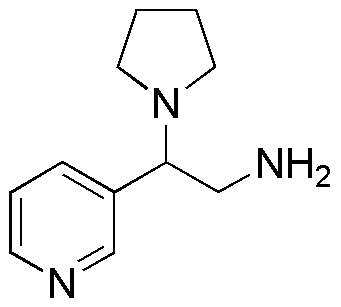2-(3-Pyridyl)-2-Pyrrolidinylethylamine is widely utilized in research focused on:
- Pharmaceutical Development: This compound serves as a key intermediate in the synthesis of novel drugs, particularly in the treatment of neurological disorders, enhancing the efficacy of therapeutic agents.
- Neuroscience Research: It is employed in studies investigating neurotransmitter systems, helping researchers understand brain function and the mechanisms behind various mental health conditions.
- Biochemical Assays: The compound is used in assays to evaluate receptor binding and activity, providing insights into drug-receptor interactions essential for drug design.
- Material Science: Its unique properties make it suitable for developing advanced materials, particularly in creating polymers with enhanced thermal and mechanical stability.
- Agrochemical Applications: This chemical is explored for its potential in formulating pesticides and herbicides, contributing to more effective agricultural practices.
General Information
Properties
Safety and Regulations
Applications
2-(3-Pyridyl)-2-Pyrrolidinylethylamine is widely utilized in research focused on:
- Pharmaceutical Development: This compound serves as a key intermediate in the synthesis of novel drugs, particularly in the treatment of neurological disorders, enhancing the efficacy of therapeutic agents.
- Neuroscience Research: It is employed in studies investigating neurotransmitter systems, helping researchers understand brain function and the mechanisms behind various mental health conditions.
- Biochemical Assays: The compound is used in assays to evaluate receptor binding and activity, providing insights into drug-receptor interactions essential for drug design.
- Material Science: Its unique properties make it suitable for developing advanced materials, particularly in creating polymers with enhanced thermal and mechanical stability.
- Agrochemical Applications: This chemical is explored for its potential in formulating pesticides and herbicides, contributing to more effective agricultural practices.
Documents
Safety Data Sheets (SDS)
The SDS provides comprehensive safety information on handling, storage, and disposal of the product.
Product Specification (PS)
The PS provides a comprehensive breakdown of the product’s properties, including chemical composition, physical state, purity, and storage requirements. It also details acceptable quality ranges and the product's intended applications.
Certificates of Analysis (COA)
Search for Certificates of Analysis (COA) by entering the products Lot Number. Lot and Batch Numbers can be found on a product’s label following the words ‘Lot’ or ‘Batch’.
Numéro de catalogue
Numéro de lot/série
Certificates Of Origin (COO)
This COO confirms the country where the product was manufactured, and also details the materials and components used in it and whether it is derived from natural, synthetic, or other specific sources. This certificate may be required for customs, trade, and regulatory compliance.
Numéro de catalogue
Numéro de lot/série
Safety Data Sheets (SDS)
The SDS provides comprehensive safety information on handling, storage, and disposal of the product.
DownloadProduct Specification (PS)
The PS provides a comprehensive breakdown of the product’s properties, including chemical composition, physical state, purity, and storage requirements. It also details acceptable quality ranges and the product's intended applications.
DownloadCertificates of Analysis (COA)
Search for Certificates of Analysis (COA) by entering the products Lot Number. Lot and Batch Numbers can be found on a product’s label following the words ‘Lot’ or ‘Batch’.
Numéro de catalogue
Numéro de lot/série
Certificates Of Origin (COO)
This COO confirms the country where the product was manufactured, and also details the materials and components used in it and whether it is derived from natural, synthetic, or other specific sources. This certificate may be required for customs, trade, and regulatory compliance.


